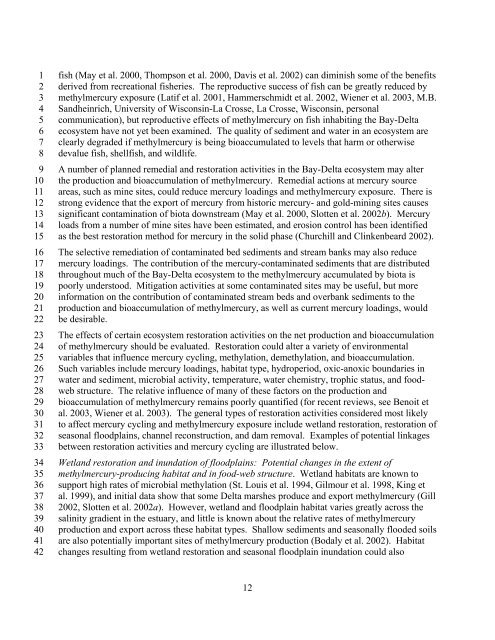Mercury Strategy for the Bay-Delta Ecosystem - CALFED Bay-Delta ...
Mercury Strategy for the Bay-Delta Ecosystem - CALFED Bay-Delta ...
Mercury Strategy for the Bay-Delta Ecosystem - CALFED Bay-Delta ...
You also want an ePaper? Increase the reach of your titles
YUMPU automatically turns print PDFs into web optimized ePapers that Google loves.
1<br />
2<br />
3<br />
4<br />
5<br />
6<br />
7<br />
8<br />
9<br />
10<br />
11<br />
12<br />
13<br />
14<br />
15<br />
16<br />
17<br />
18<br />
19<br />
20<br />
21<br />
22<br />
23<br />
24<br />
25<br />
26<br />
27<br />
28<br />
29<br />
30<br />
31<br />
32<br />
33<br />
34<br />
35<br />
36<br />
37<br />
38<br />
39<br />
40<br />
41<br />
42<br />
fish (May et al. 2000, Thompson et al. 2000, Davis et al. 2002) can diminish some of <strong>the</strong> benefits<br />
derived from recreational fisheries. The reproductive success of fish can be greatly reduced by<br />
methylmercury exposure (Latif et al. 2001, Hammerschmidt et al. 2002, Wiener et al. 2003, M.B.<br />
Sandheinrich, University of Wisconsin-La Crosse, La Crosse, Wisconsin, personal<br />
communication), but reproductive effects of methylmercury on fish inhabiting <strong>the</strong> <strong>Bay</strong>-<strong>Delta</strong><br />
ecosystem have not yet been examined. The quality of sediment and water in an ecosystem are<br />
clearly degraded if methylmercury is being bioaccumulated to levels that harm or o<strong>the</strong>rwise<br />
devalue fish, shellfish, and wildlife.<br />
A number of planned remedial and restoration activities in <strong>the</strong> <strong>Bay</strong>-<strong>Delta</strong> ecosystem may alter<br />
<strong>the</strong> production and bioaccumulation of methylmercury. Remedial actions at mercury source<br />
areas, such as mine sites, could reduce mercury loadings and methylmercury exposure. There is<br />
strong evidence that <strong>the</strong> export of mercury from historic mercury- and gold-mining sites causes<br />
significant contamination of biota downstream (May et al. 2000, Slotten et al. 2002b). <strong>Mercury</strong><br />
loads from a number of mine sites have been estimated, and erosion control has been identified<br />
as <strong>the</strong> best restoration method <strong>for</strong> mercury in <strong>the</strong> solid phase (Churchill and Clinkenbeard 2002).<br />
The selective remediation of contaminated bed sediments and stream banks may also reduce<br />
mercury loadings. The contribution of <strong>the</strong> mercury-contaminated sediments that are distributed<br />
throughout much of <strong>the</strong> <strong>Bay</strong>-<strong>Delta</strong> ecosystem to <strong>the</strong> methylmercury accumulated by biota is<br />
poorly understood. Mitigation activities at some contaminated sites may be useful, but more<br />
in<strong>for</strong>mation on <strong>the</strong> contribution of contaminated stream beds and overbank sediments to <strong>the</strong><br />
production and bioaccumulation of methylmercury, as well as current mercury loadings, would<br />
be desirable.<br />
The effects of certain ecosystem restoration activities on <strong>the</strong> net production and bioaccumulation<br />
of methylmercury should be evaluated. Restoration could alter a variety of environmental<br />
variables that influence mercury cycling, methylation, demethylation, and bioaccumulation.<br />
Such variables include mercury loadings, habitat type, hydroperiod, oxic-anoxic boundaries in<br />
water and sediment, microbial activity, temperature, water chemistry, trophic status, and foodweb<br />
structure. The relative influence of many of <strong>the</strong>se factors on <strong>the</strong> production and<br />
bioaccumulation of methylmercury remains poorly quantified (<strong>for</strong> recent reviews, see Benoit et<br />
al. 2003, Wiener et al. 2003). The general types of restoration activities considered most likely<br />
to affect mercury cycling and methylmercury exposure include wetland restoration, restoration of<br />
seasonal floodplains, channel reconstruction, and dam removal. Examples of potential linkages<br />
between restoration activities and mercury cycling are illustrated below.<br />
Wetland restoration and inundation of floodplains: Potential changes in <strong>the</strong> extent of<br />
methylmercury-producing habitat and in food-web structure. Wetland habitats are known to<br />
support high rates of microbial methylation (St. Louis et al. 1994, Gilmour et al. 1998, King et<br />
al. 1999), and initial data show that some <strong>Delta</strong> marshes produce and export methylmercury (Gill<br />
2002, Slotten et al. 2002a). However, wetland and floodplain habitat varies greatly across <strong>the</strong><br />
salinity gradient in <strong>the</strong> estuary, and little is known about <strong>the</strong> relative rates of methylmercury<br />
production and export across <strong>the</strong>se habitat types. Shallow sediments and seasonally flooded soils<br />
are also potentially important sites of methylmercury production (Bodaly et al. 2002). Habitat<br />
changes resulting from wetland restoration and seasonal floodplain inundation could also<br />
12

















